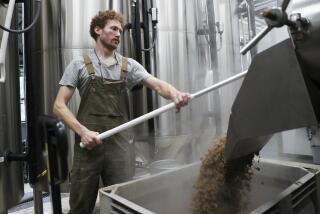White Lightning in Clean Air Fight : Pollution: The stuff of stills and moonshiners gets a veneer of respectability as ethanol. The grain alcohol, made from corn, is used to reduce emissions from cars.
HAMBURG, Iowa — Twelve years ago, Roger Hill paid $50 for his first corn liquor recipe. Now he manages a still that produces 6.5 million gallons of white lightning every year.
“We work 24 hours a day, seven days a week,” said Hill, plant manager of the Manildra Energy Corp. distillery in Hamburg. “We sell all we make; the demand is there.”
And now, perhaps, the demand is greater than ever. Grain alcohol, or ethanol--the white lightning that Snuffy Smith of cartoon fame and other moonshiners produce in back-country stills--is used as a gasoline additive to cut emissions in automobiles.
Under the Clean Air Act Amendments of 1990, vehicles in 44 high-pollution U.S. cities must cut carbon monoxide emissions by using fuels with additives like ethanol by Oct. 1, 1992. Eric Vaughn, president of the Washington-based Renewable Fuels Assn., estimates this will mean a 33% to 56% jump in ethanol consumption over five years. After many ups and downs, said Vaughn and others, ethanol’s time has come.
“Even the high-water mark is not so high,” Vaughn said. “Our feeling is that if you take a look at (the Clean Air Act), we estimate that between now and 1995, you can see potentially doubling the size of the industry.”
Just as important--at least in the short term--is the Persian Gulf War, which has kept oil prices above $30 per barrel for most of the last three months--although President Bush’s diplomatic initiative recently drove the price down more than $4 to $28.85.
Even with a government subsidy, ethanol costs more than gasoline, but high oil prices make it economically attractive, which pleases the nation’s corn farmers. Grain alcohol can be made from almost anything containing starch, sugar or even cellulose, but 95% of U.S. ethanol comes from corn. In 1989, 39 U.S. distilleries used 325 million bushels of corn--about 4% of the 7.53 billion bushels harvested--to make 825 million gallons of ethanol.
The industry predicts that production will rise to 900 million gallons this year and keep rising. Small wonder that Nebraskans are displaying bumper stickers bearing the caricature of an Arab tank driver and the inscription, “No thanks Iraq, I use ethanol!”
Said Lisle Cook, president of the Iowa Corn Growers Assn.: “Keep our fields pumping instead of our oil wells pumping. We can replace a good share of the oil that we are losing from what’s happening in the Middle East.”
But Manildra Energy’s Hill, a bruised veteran of the ethanol wars, cautioned against being overly optimistic: “If (Iraqi President) Saddam (Hussein) had a dream, and Allah said, ‘Get out of Kuwait,’ what happens? Oil futures drop like a stone. I’ll wait and see.”
Hill, a soft-spoken true believer in his 50s, left the banking business in the late 1970s to join the fledgling crusade for clean-burning renewable fuels. He dates his participation from the day in 1978 when he bought an alcohol formula for $50 from another ethanol pioneer who had been indicted in Minnesota for running an illegal still.
“During Prohibition most of the books on making alcohol were burned,” Hill said. “Of course, there are people in these whiskey companies who have formulas, but they’ve kept the secret for years.”
The oil shock that followed the 1979 overthrow of the shah of Iran gave ethanol a dramatic boost. Hill, who became what he calls a “nuts-and-bolts” guy in the industry, built two small ethanol plants in Illinois, and things went well for a few years.
But in the mid-1980s, oil prices started to drop and corn prices started to rise, a deadly combination that in the ethanol business can turn modest success into unmitigated disaster almost overnight. “By the middle of 1985,” Hill said, “almost everyone who was in the business had to get out.”
Hill returned to the business in 1987 as manager of the Manildra plant in Hamburg, a tiny town in Iowa’s southwestern corner. Manildra is an Australia-based multinational, and Hamburg has its only ethanol plant in the United States. The distillery sells almost all of its annual production to fuel distributors in nearby Council Bluffs and Omaha.
Making ethanol, stripped of all its refinements, is a simple process, almost as old as drunkenness itself. Manildra grinds corn kernels into a flour that it mixes with water and enzymes. That concoction is put into settling tanks where the cornstarch is broken down into sugar.
Add yeast, and the sugar ferments into corn beer, a yellow unpleasant swill that looks like off-colored curdled milk and smells like a Guadalajara gin mill after a heavy night of tacos and Tecate. “Breweries brew for taste,” Hill noted, “We brew for strength.”
Out of the vat and into the still, the beer is heated to 173 degrees Fahrenheit. The alcohol flashes off into a separate container and condenses into a mixture that is 110 proof (55% alcohol). Two more distilling cycles and the result is 100% alcohol. The whole process takes 40 to 44 hours.
Manildra has only 34 full-time employees. All stages of the process are closely monitored by computer, because although the basics may be simple, the subtle touches are not. Maintaining proper temperatures, pressures, volumes and chemistries is the secret to success in making grain alcohol in bulk. Snuffy Smith would certainly recognize the end product, but he wouldn’t know how to get there.
More to Read
Inside the business of entertainment
The Wide Shot brings you news, analysis and insights on everything from streaming wars to production — and what it all means for the future.
You may occasionally receive promotional content from the Los Angeles Times.










